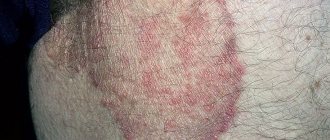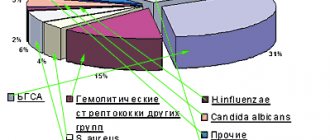About the disease
Herpetic infection is a collective concept that is used to refer to diseases that are provoked by different types of the virus of the same name.
Traditionally, in pediatric practice, pathology caused by type 1 is encountered. This is the so-called labial herpes (rash on the lips). Its peculiarity is its chronic course. It is impossible to completely get rid of the pathogen. With adequate treatment of a child with symptoms of labial herpes, stable remission can be achieved. However, at this time the virus “hides” in the nerve ganglia (ganglia), where it can remain inactive for as long as desired. When favorable conditions arise (primarily decreased appetite), it is activated again. Another common form of herpes infection that can occur in children is varicella (chickenpox). The disease is provoked by the herpes virus type 3. It is important to remember that after successful recovery, the pathogen also goes into a latent form and persists in the nerve ganglia. The risk for the patient may be a reoccurrence of the infection. The type 3 virus, when reactivated, can cause herpes zoster, which is characterized by a more pronounced clinical picture with a deterioration in the child’s well-being and the appearance of rashes along the intercostal nerves.
The specialists of the SM-Doctor clinic have extensive experience in early diagnosis and treatment of all pathologies caused by herpes viruses. Doctors provide the necessary monitoring and quality treatment for children with any form of herpetic infection.
Virus activity
Most often, children are faced with the herpes simplex virus, which manifests itself in the form of that same cold on the lips.
Herpes on the lips or chickenpox are not as dangerous for a child as herpetic lesions of the eyes, genitals, and internal organs.
Externally, herpes appears as a rash on the skin or mucous membranes. It usually looks like small blisters that eventually burst and become sores. In addition to the rash, there is burning and itching.
How often the herpes virus is activated is influenced by hereditary predisposition and the state of the immune system. The weaker the child’s immunity, the more susceptible he is to virus attacks.
Newborns up to 1 year of age are protected by maternal antibodies. The peak incidence is observed at the age of 2-3 years. By the age of 15, up to 90% of adolescents are infected with HSV. The pathogen is in an inactive state in the body and does not cause discomfort. Under unfavorable conditions, HSV is activated. Source: A. Taieb, N. Diris, F. Boralevu, C. Labreze Herpes simplex in children. Clinical manifestations, diagnostic value of clinical signs, clinical course // Ann Dermatol Venerol, 2002, v.129, No. 4, p.603—608
Causes of exacerbations and relapses of herpes in children:
- decreased immunity due to severe and prolonged illnesses;
- severe shocks and chronic stress;
- systematic fatigue;
- hypothermia;
- taking hormonal medications;
- endocrine pathologies;
- hormonal changes in adolescence;
- systematic unbalanced diet;
- complicated seasonal colds;
- chemical and radiation anticancer therapy;
- excessive physical activity. Source: M.N. Kankasova, O.G. Mokhova, O.S. Pozdeeva Frequently ill children: the view of an infectious disease specialist // Practical Medicine, 2014, No. 9(85), pp. 67-71
Herpes symptoms
Labial herpes is the simplest and most harmless form of the disease, which occurs most often in children. Apart from discomfort for the baby and parents, in most cases the disease is not accompanied by serious consequences. Typical clinical picture:
- the formation of painful blisters filled with serous fluid in the lip area;
- itching and burning in places where skin elements appear;
- loss of appetite. Breasts may refuse to breastfeed due to pain during feeding;
- general weakness, lethargy, emotional lability;
- increase in body temperature to 37-37.5 ° C (rare).
With adequate treatment, signs of the disease can disappear after 3-4 days.
Chicken pox is a typical representative of “childhood infections”. The disease is accompanied by the appearance of rashes with serous contents throughout the body of a small patient. A characteristic feature that allows you to quickly differentiate chickenpox from other infectious pathologies is the obligatory presence of pustules on the scalp and the formation of crusts after removal of the blisters. The disease is also accompanied by a rise in body temperature to 38-39.5 ° C. The severity of the pathology depends on the individual characteristics of the child’s immune system and the aggressiveness of the pathogen.
Herpes zoster is accompanied by:
- the occurrence of rashes along the intercostal nerves;
- severe pain in the area where the pustules spread;
- high fever;
- pronounced general intoxication syndrome.
If you detect at least one of these symptoms, you should immediately consult a doctor. SM-Doctor specialists point out that chicken pox and herpes zoster are diseases that require isolation of a small patient in a hospital to monitor his condition and prevent the spread of the pathogen to other family members and the environment.
Herpesvirus infections in children: modern treatment options
In recent years, herpes viruses have occupied a special place among the main causative agents of viral infections in children, which is associated with their widespread distribution, wide diversity, multiple organ lesions, variety of clinical manifestations, as well as a high frequency of chronicity. Herpes-associated diseases are among the most common and poorly controlled human infections. This is due to the fact that herpes viruses can circulate for a long time asymptomatically in the body of a person with a normal immune system, and with immunosuppression, contribute to the development of severe diseases, including life-threatening generalized infections. Thus, according to the World Health Organization (WHO), the mortality rate from herpes infection is about 16% and is in second place after hepatitis among viral diseases [1].
Herpes viruses (from the Greek ?ρπειν (herpein) - to crawl) are a family of DNA viruses, united in the Herpesviridae family, which includes 8 classified types of human viruses: herpes simplex viruses - herpes simplex virus (HSV-1) and genital herpes (HSV-2), varicella-zoster virus, Epstein-Barr virus, cytomegalovirus, human herpes virus types 6, 7, 8, as well as about 80 unclassified human and animal herpes viruses. The subfamily of α-herpes viruses includes HSV-1, HSV-2 and varicella zoster virus, which are characterized by rapid replication in various cell types and have a cytopathic effect on infected cell cultures. Beta herpes viruses (cytomegalovirus, herpes viruses types 6 and 7) also affect various types of cells, lead to an increase in their size (cytomegaly), and can contribute to the development of immunosuppressive conditions. The subfamily of γ-herpes viruses includes Epstein–Barr virus and herpes virus type 8 - Kaposi's sarcoma-associated virus (KSHV). They are characterized by tropism for lymphoid cells (T- and B-lymphocytes), in which they can persist for a long time. In some cases, they can cause the development of lymphoma and sarcoma [2].
For the synthesis of viral proteins and the formation of the virus envelope, its capsid and the DNA of “daughter” virions, amino acids, lipoproteins and nucleosides of the host cell are required. As intracellular reserves are depleted, these molecules enter the infected cell from the interstitial spaces. Due to the fact that herpes viruses directly depend on the intensity of intracellular metabolism in the human body, they colonize predominantly the cells of the epithelium, mucous membranes, blood and lymphoid tissue, which have the highest metabolic rate.
Virions of herpes viruses are thermolabile - they are inactivated within 30 minutes at a temperature of 50–52 °C, within 20 hours at a temperature of 37.5 °C, but tolerate lyophilization well. On metal surfaces (coins, door handles, water taps) herpes viruses survive for 2 hours, on plastic and wood - up to 3 hours, on wet medical materials (cotton wool and gauze) - until they dry at room temperature (up to 6 hours ). The uniqueness of herpes viruses lies in the fact that they are capable of continuously or cyclically multiplying in infected cells of tropic tissues (persistence), as well as being preserved for life in a morphologically and immunochemically modified form in the nerve cells of regional nerve ganglia (latency) and being reactivated under the influence of various exogenous agents. and endogenous provoking factors. However, the ability for persistence and latency varies among different strains: the most active in this regard are herpes simplex viruses, the least active is the Epstein-Barr virus.
According to numerous studies, by the age of 18, more than 90% of urban residents are infected with one or more strains of viruses. The main route of infection is airborne, through direct contact or through household items (shared dishes, towels, handkerchiefs, etc.). Oral, genital, transfusion, transplantation and transplacental routes of transmission of infection are also noted. HSV types 1 and 2, cytomegalovirus are among the causative agents of TORCH infections, contributing to the development of serious diseases in newborns and young children. Herpes simplex viruses, cytomegalovirus, and Epstein–Barr virus are considered indicators of AIDS due to their frequent detection in this disease [3, 4]. The development of chronic fatigue syndrome (CFS) is associated with herpes viruses [5].
Clinically, herpes infection in children can occur in the form of chickenpox (varicella-zoster virus), infectious mononucleosis (Epstein-Barr virus), sudden exanthema (human herpes virus types 6 and 7), aphthous stomatitis (HSV 1 or type 2), mononucleosis-like syndrome (cytomegalovirus). In adolescents and adults, the infection is often asymptomatic, which is explained both by the biological properties of the strains and by the individual characteristics of the immune response. Often, when the body’s immunoreactivity decreases, herpes viruses act as opportunist viruses, leading to a more severe course of the underlying disease and the development of complications. The role of herpesvirus infections, especially cytomegalovirus, in the formation of infant mortality is great. The greatest threat to the life and health of children is posed by herpetic neuroinfections - their mortality rate reaches 20%, and disability - 50%. Ophthalmoherpes (development of cataracts or glaucoma - up to 50%), genital herpes, and a generalized form of Epstein-Barr virus infection (infectious mononucleosis) are severe [1, 6].
Herpes virus infection is a difficult to control disease. Despite the variety of medications used to treat this pathology, there is no means of providing a complete cure. This is due to the genotypic characteristics of the pathogen, the formation of resistance of herpes viruses and molecular mimicry.
The mechanisms of replication of herpes viruses discovered using molecular biology methods, as well as the study of the interaction of the virus with the cell, have made it possible to create a number of effective chemotherapeutic agents with antiherpetic activity. However, while effectively stopping acute manifestations of infection, they do not prevent relapses and do not always reduce the frequency of relapses.
Considering that with herpes-associated infections, as with other chronic diseases with long-term persistence of the virus, immunodeficiency states develop, in order to increase the effectiveness of treatment, treatment regimens, along with antiviral drugs, must include drugs that help correct the patient’s immune status. All this dictates the need to correctly select the drug, its dose and duration of administration, and, if necessary, use a combination of different drugs, while avoiding polypharmacy. A certain complexity of therapy in childhood is caused by age restrictions for a number of drugs, the presence of adverse drug reactions (ADRs) and contraindications.
Currently, the following groups of drugs are used to treat herpesvirus diseases and prevent relapses (table).
When treating herpes infections, an integrated approach should be followed. The duration and intensity of therapy are determined by the patient’s age, the clinical form of the disease, the severity of its course, as well as the presence of complications and concomitant pathologies. Treatment and preventive measures should be divided into several stages.
- Acute period of illness (relapse) - protective regimen, therapeutic nutrition, antiviral drugs, interferons and their inducers. According to indications, immunoglobulins, antibacterial drugs of local and systemic action, glucocorticoids, neuro- and angioprotectors, hepatoprotectors, cardiotropic drugs, protease inhibitors are prescribed. Symptomatic therapy may include antipyretic, expectorant and mucolytic drugs.
- Remission, subsidence of the main clinical manifestations (immunomodulators, adaptogens of plant origin, pre- and probiotics, vitamin-mineral complexes).
- Prevention of relapses (specific prevention - vaccination, sanitation of chronic foci of infection, restoration of immune status, etc.).
It should be noted that the combined use of antiviral drugs and immunobiological agents has a number of advantages. Firstly, complex therapy provides a synergistic effect. Secondly, it allows you to reduce the dose of an antiviral chemotherapy drug, reducing the likelihood of developing ADRs, reducing its toxic effects on the body and reducing the likelihood of the emergence of resistant strains of herpes viruses. In addition, it significantly reduces the duration of the acute period of the disease and the treatment time.
One of the drugs that has shown its effectiveness in the treatment of herpes-associated diseases in children is inosine pranobex. Inosine pranobex is a synthetic complex purine derivative with immunostimulating activity and nonspecific antiviral effect. The drug restores the functions of lymphocytes in conditions of immunosuppression, increases blastogenesis in the population of monocytic cells, stimulates the expression of membrane receptors on the surface of T-helpers, has a stimulating effect on the activity of cytotoxic T-lymphocytes and natural killer cells, the functions of T-suppressors and T-helpers, increases the production of immunoglobulin G, interferons, interleukins (IL-1 and IL-2), reduces the formation of proinflammatory cytokines (IL-4 and IL-10), potentiates the chemotaxis of neutrophils, monocytes and macrophages. The mechanism of the antiviral action of the drug is associated with the inhibition of viral RNA and the enzyme dihydropteroate synthetase, which is involved in replication, enhancing the synthesis of lymphocyte mRNA suppressed by viruses, which is accompanied by inhibition of the biosynthesis of viral RNA and the translation of viral proteins.
Inosine pranobex is low toxic, well tolerated, in Russia it is recommended in the form of tablets for children from 3 years of age (body weight more than 15 kg). Abroad, it is also available in syrup form and has no age restrictions. The drug is prescribed at 50–100 mg/kg/day orally in 3–4 doses throughout the entire acute period of the disease (5–10 days, depending on the duration of viremia and the severity of the intoxication syndrome). As maintenance therapy to restore immunological parameters, it is possible to prescribe the drug according to an immunomodulatory regimen (50 mg 2 times a day for 14–28 days). The high effectiveness of course therapy with inosine pranobex (50 mg/kg body weight per day in 3-4 doses orally, three courses of treatment for 10 days with an interval of 10 days) [7], combined course therapy using inosine pranobex and recombinant interferon α- 2β (3 courses of 10 days with an interval of 14 days) in children with mixed viral infections [8].
The use of inosine pranobex as a drug with immunotropic and antiviral effects at various stages of treatment and prophylactic measures allows one to avoid polypharmacy, thereby reducing the drug burden on the body and reducing the risk of undesirable effects.
Literature
- Kuskova T.K., Belova E.G. The family of herpes viruses at the present stage // Attending Physician. 2004, No. 5, p. 64–69.
- Hjalgrim H., Askling J., Rostgaard K. et al. Characteristics of Hodgkin's lymphoma after infectious mononucleosis // N. Engl. J. Med. 2003; 349:1324–1332.
- Nikolsky I. S., Yurchenko V. D., Nikolskaya K. I. Characteristics of active chronic Epstein–Barr viral infection: clinical and immunological syndrome // Modern infections. 2003, No. 3, p. 60–62.
- Katz BZ, Shiraishi Y., Mears CJ, Binns HJ, Taylor R. Chronic fatigue syndrome after infectious mononucleosis in adolescents // Pediatrics. 2009, Jul; 124(1):189–193.
- Lerner AM, Begar SN, Deeter RG IgM serum antibodies to Epstein-Barr virus are uniquely present in a subset of patients with the chronic fatigue syndrome // In Vivo. 2004, Mar-Apr; 18 (2): 101–106.
- Maakaroun NR, Moanna A., Jacob JT, Albrecht H. Viral infections associated with haemophagocytic syndrome // Rev. Med. Virol. 2010, Mar; 20 (2): 93–105.
- Simovanyan E. N., Denisenko V. B., Grigoryan A. V. The effectiveness of the use of inosine pranobex in frequently ill children with chronic Epstein-Barr viral infection: results of a randomized study // Issues of modern pediatrics. 2011, T. 10, No. 2, pp. 16–21.
- Nesterova I. V., Kovaleva S. V., Chudilova G. A., Lomtatidze L. V., Kleshchenko E. I., Shinkareva O. N. Dynamics of changes in the phenotype and functional activity of neutrophil granulocytes in immunocompromised children with repeated acute respiratory viral infections, associated with herpesvirus infections, against the background of combined interferon and immunotherapy // Cytokines and inflammation. 2014, T. 13, No. 1, p. 113.
T. A. Bokova, Doctor of Medical Sciences, Professor
GBUZ MO MONIKI named after. M. F. Vladimirsky, Moscow
Contact Information
Causes of herpes
All variants of herpes infection occur against the background of the activity of the virus of the same name of different types. Since upon initial penetration into the human body the pathogen no longer leaves it, it is important to know the factors that can provoke the activation of the disease:
- hypothermia;
- seasonal colds;
- any conditions that provoke a decrease in immune defense (poor nutrition, hypovitaminosis and others);
- exacerbation of chronic somatic diseases;
- contact with an infected patient.
The virus is transmitted by airborne droplets, so it is extremely difficult to completely prevent a child from encountering pathogenic particles.
Epstein-Barr virus infection
An infectious disease caused by the Epstein-Barr virus (EBV) and characterized by a systemic lymphoproliferative process with a benign or malignant course.
EBV is isolated from the body of a patient or virus carrier with oropharyngeal secretions. Transmission of the infection occurs through airborne droplets through saliva, often when a mother kisses her child, which is why EBV infection is sometimes called the “kissing disease.” Children often become infected with EBV through toys contaminated with the saliva of a sick child or a virus carrier, when using shared utensils and linen. Blood transfusion and sexual transmission of the infection are possible. Cases of vertical transmission of EBV from mother to fetus have been described, suggesting that the virus may be the cause of intrauterine developmental anomalies. Contagiousness during EBV infection is moderate, which is probably due to the low concentration of the virus in saliva. The activation of infection is influenced by factors that reduce general and local immunity. The causative agent of EBV infection has a tropism for the lymphoid-reticular system. The virus penetrates the B-lymphoid tissues of the oropharynx and then spreads throughout the body's lymphatic system. Infection of circulating B lymphocytes occurs. The DNA virus penetrates into the nuclei of cells, while the proteins of the virus give infected B-lymphocytes the ability to continuously multiply, causing the so-called “immortality” of B-lymphocytes. This process is a characteristic feature of all forms of EBV infection.
EBV can cause: infectious mononucleosis, Burkitt's lymphoma, nasopharyngeal carcinoma, chronic active EBV infection, leiomyosarcoma, lymphoid interstitial pneumonia, hairy leukoplakia, non-Hodgkin's lymphoma, congenital EBV infection.
Diagnosis of herpes
"SM-Doctor" is a multidisciplinary clinic specializing in providing high-quality medical services to children of any age. Diagnosis of herpetic infections in our center is carried out according to the standards used in leading clinics in Europe and the world. Our specialists establish a preliminary diagnosis at the stage of the initial examination of the child. Depending on the severity of the clinical picture, the necessary auxiliary diagnostic procedures are selected:
- a set of standard laboratory tests (general blood test, urine test, blood “biochemistry”, etc.);
- specific serological tests (ELISA) to detect antibodies to a specific type of virus in the patient’s blood;
- Polymerase chain reaction (PCR) is a highly informative diagnostic method that allows you to detect the presence of a virus in a child’s body with up to 99% accuracy.
"SM-Doctor" is a multidisciplinary center. Thanks to this, if necessary (for example, if complications develop), our patients can be examined by a wide range of specialists in different fields. If the attending physician, in addition to infection, suspects a pathology of internal organs and systems, he refers the sick child for consultation with a cardiorheumatologist, ophthalmologist, neurologist and others. In a short period of time, the child receives a full range of diagnostic services aimed at identifying any abnormalities in the functioning of the body.
Complications of herpes in infants
What are the complications of herpes in a child? In infants, herpes can be complicated by the following types of diseases:
- the cardiovascular system is affected;
- cerebral palsy;
- paralysis;
- disturbance in the hematopoietic process;
- encephalitis;
- herpes eyes;
- meningitis;
- hepatitis;
- eczema Galoshes.
To prevent the development or occurrence of the disease, it is worth making sure that the baby’s immune defense is at a high level. It is necessary to carry out hardening procedures and ensure that the child spends enough time in the fresh air. It is important to maintain a certain temperature and humidity in the nursery.
During the prenatal period, expectant mothers need to be screened for the herpes virus. Pregnant women should also take precautions to avoid infection. For example, do not communicate with people who carry this virus, do not use their things, etc.
Treatment of herpes
SM-Doctor doctors select treatment for herpetic infection for each child individually.
Our specialists prescribe medications depending on the severity of the clinical picture of the pathology and the presence of concomitant diseases. The following means are traditionally used to combat the virus:
- acyclovir is a specific drug to destroy the pathogen;
- antipyretic medications (paracetamol, ibuprofen) for fever above 38°C;
- auxiliary medications (painkillers, antiallergic and others).
Cytomegalovirus infection
Cytomegalovirus infection is characterized by the formation of giant cells and specific infiltrates in the affected organs, a latent (asymptomatic) course in individuals with a normal immune system and with clinical manifestations in immunodeficiency states, mainly in young children.
Clinical forms of cytomegalovirus infection (CMVI):>
Congenital CMV infection is infection from the mother during pregnancy and childbirth and acquired, which is often asymptomatic. The full clinical picture of CMV infection is characterized by:
- increase in body temperature;
- lethargy;
- drowsiness;
- adynamia;
- enlarged lymph nodes, liver, spleen, salivary glands;
- rash;
- other organs are involved (lungs, kidneys, central nervous system).
The disease has an undulating, relapsing course, reminiscent of the clinical picture of infectious mononucleosis.
Prevention of herpes
The basic rules that will help reduce the likelihood of infection with viruses of the herpes family are:
- hand washing;
- limiting contact with sick people;
- nasal instillation with saline solutions during the off-season.
There is now a vaccine against chickenpox. Vaccination helps prevent infection and/or development of severe forms of the disease. “SM-Doctor” is a multidisciplinary medical institution that provides effective treatment to children facing various diseases. Herpetic infection in any of its manifestations is not a problem. The main thing is to schedule a consultation with our specialists on time. Contact us!
When to see a doctor
With a primary infection, the child almost always develops a fever. The baby has no appetite, anxiety, crying, and sleep disturbances. If one of the above symptoms is present or if there are several of them, you need to immediately show the newborn to a specialist - a pediatrician (children's doctor) or a dermatovenerologist.
If the infection develops, it can lead to complications, including death. The herpes virus in newborns should be identified as quickly as possible so that treatment can begin without delay. If there are signs of herpes in an infant, you can visit JSC “Medicine” (academician Roitberg’s clinic) in the center of Moscow. The Pediatrics Department has a staff of highly qualified specialists, new generation equipment and instruments for examination. You can make an appointment with a pediatrician or dermatovenerologist on the website or by calling +7(495)993-00-33.
Herpes virus type 8
Herpes virus type 8 can cause Kaposi's sarcoma and Castleman's disease. Kaposi's sarcoma is a serious pathology that is accompanied by the appearance of malignant skin tumors. It is quite difficult, especially with immune deficiency. May be complicated by inflammation of the mucous membrane of the palate and lymph nodes.
Castleman's disease is a rare disease in which fever, enlargement of the liver and spleen, anemia, and a sharp decrease in body weight are observed.






